Justus Thies
Max Planck Institute for Intelligent Systems
Synthetic Prior for Few-Shot Drivable Head Avatar Inversion
Jan 12, 2025Abstract:We present SynShot, a novel method for the few-shot inversion of a drivable head avatar based on a synthetic prior. We tackle two major challenges. First, training a controllable 3D generative network requires a large number of diverse sequences, for which pairs of images and high-quality tracked meshes are not always available. Second, state-of-the-art monocular avatar models struggle to generalize to new views and expressions, lacking a strong prior and often overfitting to a specific viewpoint distribution. Inspired by machine learning models trained solely on synthetic data, we propose a method that learns a prior model from a large dataset of synthetic heads with diverse identities, expressions, and viewpoints. With few input images, SynShot fine-tunes the pretrained synthetic prior to bridge the domain gap, modeling a photorealistic head avatar that generalizes to novel expressions and viewpoints. We model the head avatar using 3D Gaussian splatting and a convolutional encoder-decoder that outputs Gaussian parameters in UV texture space. To account for the different modeling complexities over parts of the head (e.g., skin vs hair), we embed the prior with explicit control for upsampling the number of per-part primitives. Compared to state-of-the-art monocular methods that require thousands of real training images, SynShot significantly improves novel view and expression synthesis.
GaussianSpeech: Audio-Driven Gaussian Avatars
Nov 27, 2024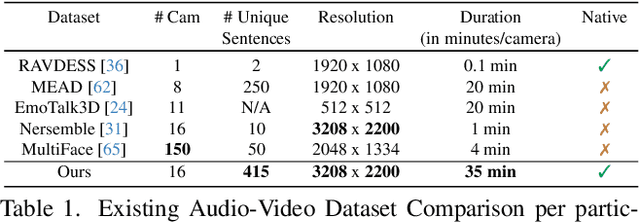
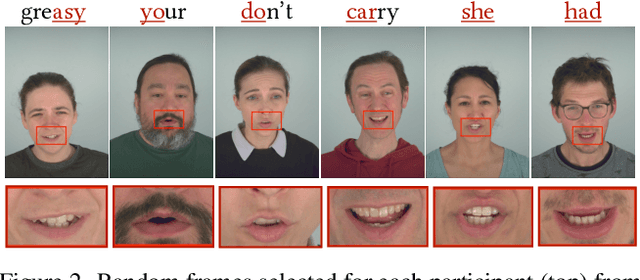
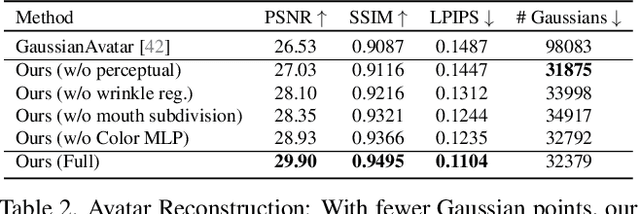
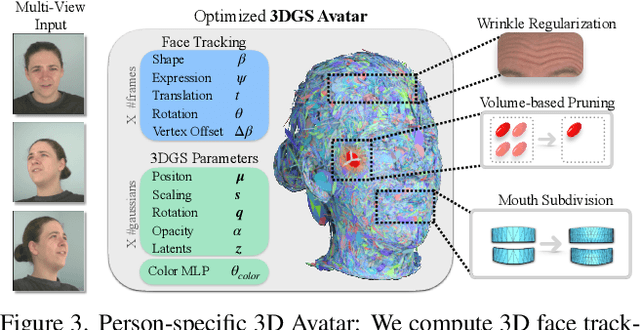
Abstract:We introduce GaussianSpeech, a novel approach that synthesizes high-fidelity animation sequences of photo-realistic, personalized 3D human head avatars from spoken audio. To capture the expressive, detailed nature of human heads, including skin furrowing and finer-scale facial movements, we propose to couple speech signal with 3D Gaussian splatting to create realistic, temporally coherent motion sequences. We propose a compact and efficient 3DGS-based avatar representation that generates expression-dependent color and leverages wrinkle- and perceptually-based losses to synthesize facial details, including wrinkles that occur with different expressions. To enable sequence modeling of 3D Gaussian splats with audio, we devise an audio-conditioned transformer model capable of extracting lip and expression features directly from audio input. Due to the absence of high-quality datasets of talking humans in correspondence with audio, we captured a new large-scale multi-view dataset of audio-visual sequences of talking humans with native English accents and diverse facial geometry. GaussianSpeech consistently achieves state-of-the-art performance with visually natural motion at real time rendering rates, while encompassing diverse facial expressions and styles.
Joker: Conditional 3D Head Synthesis with Extreme Facial Expressions
Oct 21, 2024


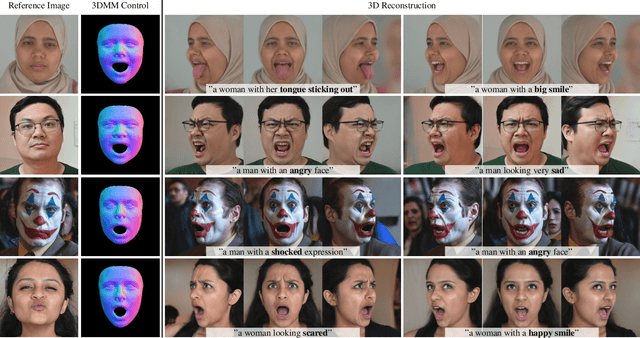
Abstract:We introduce Joker, a new method for the conditional synthesis of 3D human heads with extreme expressions. Given a single reference image of a person, we synthesize a volumetric human head with the reference identity and a new expression. We offer control over the expression via a 3D morphable model (3DMM) and textual inputs. This multi-modal conditioning signal is essential since 3DMMs alone fail to define subtle emotional changes and extreme expressions, including those involving the mouth cavity and tongue articulation. Our method is built upon a 2D diffusion-based prior that generalizes well to out-of-domain samples, such as sculptures, heavy makeup, and paintings while achieving high levels of expressiveness. To improve view consistency, we propose a new 3D distillation technique that converts predictions of our 2D prior into a neural radiance field (NeRF). Both the 2D prior and our distillation technique produce state-of-the-art results, which are confirmed by our extensive evaluations. Also, to the best of our knowledge, our method is the first to achieve view-consistent extreme tongue articulation.
Stable Video Portraits
Sep 26, 2024



Abstract:Rapid advances in the field of generative AI and text-to-image methods in particular have transformed the way we interact with and perceive computer-generated imagery today. In parallel, much progress has been made in 3D face reconstruction, using 3D Morphable Models (3DMM). In this paper, we present SVP, a novel hybrid 2D/3D generation method that outputs photorealistic videos of talking faces leveraging a large pre-trained text-to-image prior (2D), controlled via a 3DMM (3D). Specifically, we introduce a person-specific fine-tuning of a general 2D stable diffusion model which we lift to a video model by providing temporal 3DMM sequences as conditioning and by introducing a temporal denoising procedure. As an output, this model generates temporally smooth imagery of a person with 3DMM-based controls, i.e., a person-specific avatar. The facial appearance of this person-specific avatar can be edited and morphed to text-defined celebrities, without any fine-tuning at test time. The method is analyzed quantitatively and qualitatively, and we show that our method outperforms state-of-the-art monocular head avatar methods.
Gaussian Eigen Models for Human Heads
Jul 05, 2024Abstract:We present personalized Gaussian Eigen Models (GEMs) for human heads, a novel method that compresses dynamic 3D Gaussians into low-dimensional linear spaces. Our approach is inspired by the seminal work of Blanz and Vetter, where a mesh-based 3D morphable model (3DMM) is constructed from registered meshes. Based on dynamic 3D Gaussians, we create a lower-dimensional representation of primitives that applies to most 3DGS head avatars. Specifically, we propose a universal method to distill the appearance of a mesh-controlled UNet Gaussian avatar using an ensemble of linear eigenbasis. We replace heavy CNN-based architectures with a single linear layer improving speed and enabling a range of real-time downstream applications. To create a particular facial expression, one simply needs to perform a dot product between the eigen coefficients and the distilled basis. This efficient method removes the requirement for an input mesh during testing, enhancing simplicity and speed in expression generation. This process is highly efficient and supports real-time rendering on everyday devices, leveraging the effectiveness of standard Gaussian Splatting. In addition, we demonstrate how the GEM can be controlled using a ResNet-based regression architecture. We show and compare self-reenactment and cross-person reenactment to state-of-the-art 3D avatar methods, demonstrating higher quality and better control. A real-time demo showcases the applicability of the GEM representation.
Generating Human Interaction Motions in Scenes with Text Control
Apr 16, 2024Abstract:We present TeSMo, a method for text-controlled scene-aware motion generation based on denoising diffusion models. Previous text-to-motion methods focus on characters in isolation without considering scenes due to the limited availability of datasets that include motion, text descriptions, and interactive scenes. Our approach begins with pre-training a scene-agnostic text-to-motion diffusion model, emphasizing goal-reaching constraints on large-scale motion-capture datasets. We then enhance this model with a scene-aware component, fine-tuned using data augmented with detailed scene information, including ground plane and object shapes. To facilitate training, we embed annotated navigation and interaction motions within scenes. The proposed method produces realistic and diverse human-object interactions, such as navigation and sitting, in different scenes with various object shapes, orientations, initial body positions, and poses. Extensive experiments demonstrate that our approach surpasses prior techniques in terms of the plausibility of human-scene interactions, as well as the realism and variety of the generated motions. Code will be released upon publication of this work at https://research.nvidia.com/labs/toronto-ai/tesmo.
Environment-Specific People
Dec 22, 2023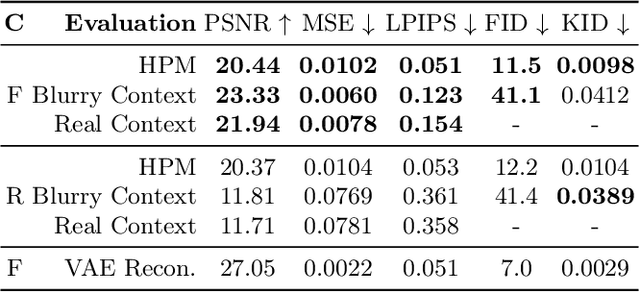
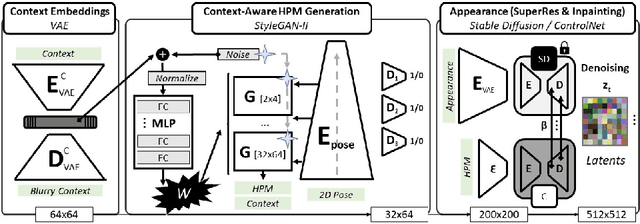


Abstract:Despite significant progress in generative image synthesis and full-body generation in particular, state-of-the-art methods are either context-independent, overly reliant to text prompts, or bound to the curated training datasets, such as fashion images with monotonous backgrounds. Here, our goal is to generate people in clothing that is semantically appropriate for a given scene. To this end, we present ESP, a novel method for context-aware full-body generation, that enables photo-realistic inpainting of people into existing "in-the-wild" photographs. ESP is conditioned on a 2D pose and contextual cues that are extracted from the environment photograph and integrated into the generation process. Our models are trained on a dataset containing a set of in-the-wild photographs of people covering a wide range of different environments. The method is analyzed quantitatively and qualitatively, and we show that ESP outperforms state-of-the-art on the task of contextual full-body generation.
HAAR: Text-Conditioned Generative Model of 3D Strand-based Human Hairstyles
Dec 18, 2023Abstract:We present HAAR, a new strand-based generative model for 3D human hairstyles. Specifically, based on textual inputs, HAAR produces 3D hairstyles that could be used as production-level assets in modern computer graphics engines. Current AI-based generative models take advantage of powerful 2D priors to reconstruct 3D content in the form of point clouds, meshes, or volumetric functions. However, by using the 2D priors, they are intrinsically limited to only recovering the visual parts. Highly occluded hair structures can not be reconstructed with those methods, and they only model the ''outer shell'', which is not ready to be used in physics-based rendering or simulation pipelines. In contrast, we propose a first text-guided generative method that uses 3D hair strands as an underlying representation. Leveraging 2D visual question-answering (VQA) systems, we automatically annotate synthetic hair models that are generated from a small set of artist-created hairstyles. This allows us to train a latent diffusion model that operates in a common hairstyle UV space. In qualitative and quantitative studies, we demonstrate the capabilities of the proposed model and compare it to existing hairstyle generation approaches.
FaceTalk: Audio-Driven Motion Diffusion for Neural Parametric Head Models
Dec 13, 2023Abstract:We introduce FaceTalk, a novel generative approach designed for synthesizing high-fidelity 3D motion sequences of talking human heads from input audio signal. To capture the expressive, detailed nature of human heads, including hair, ears, and finer-scale eye movements, we propose to couple speech signal with the latent space of neural parametric head models to create high-fidelity, temporally coherent motion sequences. We propose a new latent diffusion model for this task, operating in the expression space of neural parametric head models, to synthesize audio-driven realistic head sequences. In the absence of a dataset with corresponding NPHM expressions to audio, we optimize for these correspondences to produce a dataset of temporally-optimized NPHM expressions fit to audio-video recordings of people talking. To the best of our knowledge, this is the first work to propose a generative approach for realistic and high-quality motion synthesis of volumetric human heads, representing a significant advancement in the field of audio-driven 3D animation. Notably, our approach stands out in its ability to generate plausible motion sequences that can produce high-fidelity head animation coupled with the NPHM shape space. Our experimental results substantiate the effectiveness of FaceTalk, consistently achieving superior and visually natural motion, encompassing diverse facial expressions and styles, outperforming existing methods by 75% in perceptual user study evaluation.
360° Volumetric Portrait Avatar
Dec 08, 2023Abstract:We propose 360{\deg} Volumetric Portrait (3VP) Avatar, a novel method for reconstructing 360{\deg} photo-realistic portrait avatars of human subjects solely based on monocular video inputs. State-of-the-art monocular avatar reconstruction methods rely on stable facial performance capturing. However, the common usage of 3DMM-based facial tracking has its limits; side-views can hardly be captured and it fails, especially, for back-views, as required inputs like facial landmarks or human parsing masks are missing. This results in incomplete avatar reconstructions that only cover the frontal hemisphere. In contrast to this, we propose a template-based tracking of the torso, head and facial expressions which allows us to cover the appearance of a human subject from all sides. Thus, given a sequence of a subject that is rotating in front of a single camera, we train a neural volumetric representation based on neural radiance fields. A key challenge to construct this representation is the modeling of appearance changes, especially, in the mouth region (i.e., lips and teeth). We, therefore, propose a deformation-field-based blend basis which allows us to interpolate between different appearance states. We evaluate our approach on captured real-world data and compare against state-of-the-art monocular reconstruction methods. In contrast to those, our method is the first monocular technique that reconstructs an entire 360{\deg} avatar.
 Add to Chrome
Add to Chrome Add to Firefox
Add to Firefox Add to Edge
Add to Edge